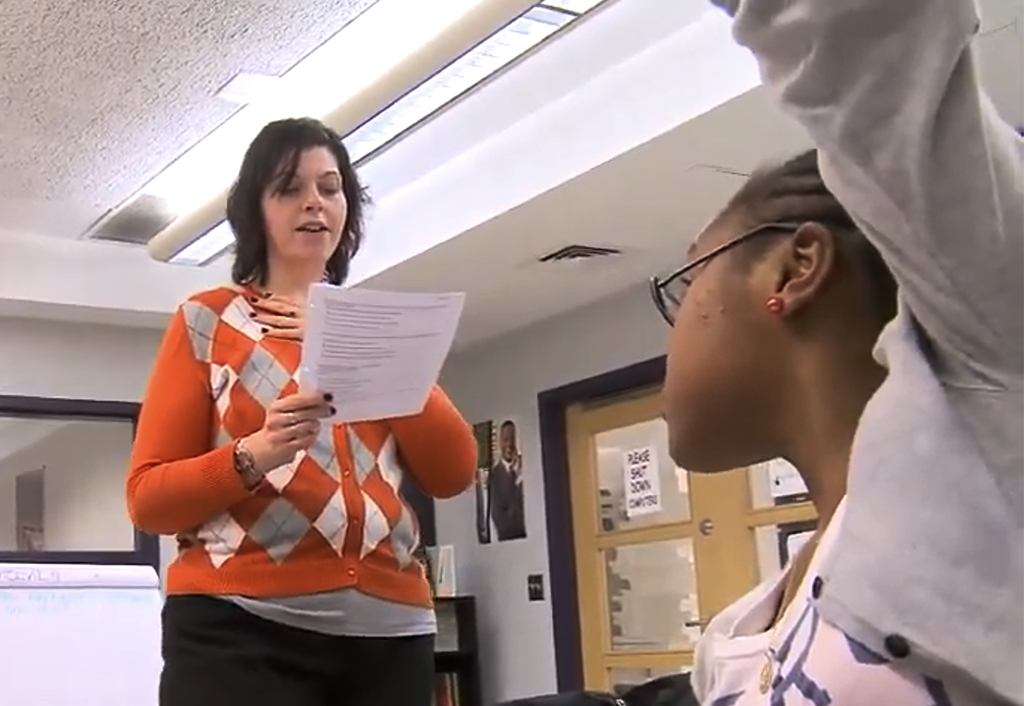Housing Authority made own system for teens, and four years after high school show it works

A Cambridge Housing Authority Work Force student raises her hand to answer an instructor question in a 2011 video explaining the program.
Fewer than 60 percent of high school graduates who continue their education complete any kind of degree or certificate program within six years, and the figures are worse for low-income students whose parents didn’t graduate from college. Now a small group of students from Cambridge public housing developments has done much better: Almost two-thirds finished their postsecondary schooling within four years.
It took a lot of work and determination by the students and a lot of help from the Cambridge Housing Authority, which runs this and other little-known programs aimed at bringing its residents out of poverty. When CHA director of resident services John Lindamood announced the results at a June 17 meeting, he called it “a pivotal moment for our work.”
For years the authority’s Work Force program has enrolled eighth-graders from public housing families and worked with them for the next five years to help them get work experience, graduate from high school, and enroll in a certificate or college program. (Thirty percent of those who join Work Force drop out of the program, though, authority officials said in 2014). That was not enough, Lindamood said.
“We began to confront this in earnest eight years ago when we began getting a lot of anecdotal information from our students that was concerning,” he said. Although almost all enrolled in some sort of postsecondary school or college, they were not finishing, attending college sporadically and incurring “exorbitant debt,” he said. And when they did graduate, “they were not getting their degree to work for them” with decent jobs, Lindamood said.
Work Force was already enfolding participants in supports, including teacher/counselors, volunteer tutors, homework centers at three housing developments and Cambridge Rindge and Latin School, “try-out” jobs to help students get a taste of employment and computer labs.
Expanding the program
Then, seven years ago, CHA started a program to help students save for college, offering to match up to $1,500 in earnings and incentives. The money goes into deposit-only accounts although students can withdraw funds for “education-related expenses,” Lindamood said.
Four years ago, Work Force hired an “alumni coach,” Rudy Luders, and two years later, a “career development specialist,” John Altidor. The two work together with high school juniors and seniors “to help students and families” choose a postsecondary program and plan for it, and they keep in touch with students after they enroll, Lindamood said.
Ordinarily, high school guidance counselors would help with choices and financial aid plans. “We work closely with the guidance staff [at Cambridge Rindge and Latin School] but they have a huge caseload and they are pulled in two directions” because of demand from white middle-class parents, Lindamood said at the authority meeting.
In an interview later, he repeated his praise of the high school guidance counselors but said: “This is what unfolds in a wealthy community like Cambridge. We’re just trying to level the playing field.”
Rising completion rate
A total of 35 Work Force students graduated from CRLS in 2016, the first class with four years with an alumni coach, two years of career advice and three years of full savings opportunity, Lindamood said. It was an unusually large class, he said.
Twenty-nine of the graduates enrolled in a college or a certificate program, Lindamood said. Nineteen, or 65 percent, have now graduated from schools such as Worcester Polytechnic Institute, Framingham State College, Georgetown University, Bentley College and Bunker Hill Community College. One student who had always wanted to be a cosmetologist finished a cosmetology program. Lindamood said some are now considering graduate school.
Most of the Work Force students are the first in their families to go on with their education, or they are following a sibling. A report updated in 2011 by the Pell Institute for the Study of Opportunity in Higher Education found that only 37 percent of low-income students whose parents didn’t have a bachelor’s degree completed a four-year or two-year program within six years of high school.
Lindamood said Luders and Altidor will continue to work with the class of 2016 students who didn’t finish. By next spring, he said, he expects the completion rate to rise to 75 percent to 80 percent.



Obviously, CRLS needs more guidance counselors. Current caseloads are close to 200 students per CRLS guidance counselor. Work Force serves only a small percentage of low-income or first-generation CRLS students. What about the others?
This is another case where Cambridge is penny wise and pound foolish. It spends almost $30,000 per student for 13-14 years while the student goes through the system JK-12, and then doesn’t offer enough guidance counselors to ensure that every student has a sound post-secondary plan when they leave CRLS. As a result, many of them go someplace inappropriate after HS, struggle, drop out, and end up with college debt and no college degree. Or they don’t go to any post-secondary program and end up working a minimum wage job. Shame on Cambridge.